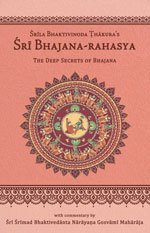Bhajana-Rahasya
by Srila Bhaktivinoda Thakura Mahasaya | 2010 | 123,965 words
The Bhajana-rahasya Text 20, English translation, including commentary (vritti). The Bhajana-rahasya is a compilation of verses describing the mercy of the eight pairs of names (Yugala-nama) of the Maha-mantra. This is text 20 belonging to the chapter “Pancama-yama-sadhana (Aparahna-kaliya-bhajana–krishna-asakti)” representing from three-and-a-half praharas of the day until dusk: approximately 3.30 p.m.–6.00 p.m.
Text 20
A prayer to become a maidservant of Śrī Rādhā, who attracts the mind of Śrī Kṛṣṇa, is found in Śrī Rādhā-rasa-sudhā-nidhi (39):
वेणुः करान् निपतितः स्खलितं शिखण्डं भ्रष्टं च पीत-वसनं व्रज-राज-सूनोः
यस्याः कटाक्ष-शर-घात-विमूर्च्छितस्य तां राधिकां परिचरामि कदा रसेनveṇuḥ karān nipatitaḥ skhalitaṃ śikhaṇḍaṃ bhraṣṭaṃ ca pīta-vasanaṃ vraja-rāja-sūnoḥ
yasyāḥ kaṭākṣa-śara-ghāta-vimūrcchitasya tāṃ rādhikāṃ paricarāmi kadā rasenaWhen will I be engaged in the rasa-laden service to Śrī Rādhā, whose arrow-like sidelong glance causes Śrī Nanda-nandana to faint, the flute to fall from His hands, the peacock feather crown to slip from His head, and His yellow cloth to fall from His body?
याङ्हार कटाक्ष-शरे श्री-कृष्ण मूर्च्छित
कर हैते वंशि खसे, शिखण्ड स्खलितyāṅhāra kaṭākṣa-śare śrī-kṛṣṇa mūrcchita
kara haite vaṃśi khase, śikhaṇḍa skhalitaपीत-वस्त्र भ्रष्ट हय, से राधा-चरण
कबे आमि रस-योगे करिब सेवन?pīta-vastra bhraṣṭa haya, se rādhā-caraṇa
kabe āmi rasa-yoge kariba sevana?
Commentary: Bhajana-rahasya-vṛtti:
Bhakti-rasāmṛta-sindhu (1.2.291) states: “teṣāṃ bhāvāptaye lubdho bhaved atrādhikāravān–(the deep attachment [anurāga] from which everfresh greed is born and which is displayed in a varigated way, manifests in an astonishing, unparalleled manner and reaches the stage of mahābhāva.) Only a person who craves to attain this kind of transcendental sentiment (bhāva ) is eligible to enter rāgamārga.”
Taste, or ruci, is the most important aspect of bhāva-bhakti. When a person has ruci for rāgānuga-bhajana in the mood of mādhuryarasa, he relishes Śrī Rādhā-Mādhava’s names, forms, qualities and pastimes in his hearing and chanting. By this kind of bhajana, one can perceive the method of the service of the nitya-siddha-mañjarīs.
In this Text, Śrī Sarasvatīpāda is praying for the nectarous loving service of Śrī Rādhā, who enchants the mind of Kānu, or Kṛṣṇa. Concealed within this verse is the influence of mādanākhyamahābhāva on the heart of Śrī Kṛṣṇa, who is the emporium of all nectarean mellows, akhila-rasāmṛta-mūrti.
Padmā and other sakhīs somehow allured Śrī Kṛṣṇa to Candrāvalī’s kuñja, leaving Śrīmatī distressed in a state of extreme separation. The clever kiṅkarīs, however, skilfully brought Him from there and submitted Him to Śrīmatī. Śrī Rādhā’s mood of contrariness was then set in motion. First, She forbade Kṛṣṇa to touch Her; then She exhibited feigned anger and cast a crooked sidelong glance at Him.
Śrī Rādhā is the embodiment of mahābhāva, and the only function of mahābhāva is to incite happiness in Śrī Kṛṣṇa’s heart. Here, mādanākhya-mahābhāva aroused countless indescribable, transcendental sentiments in the heart of akhila-rasāmṛta-mūrti Śrī Kṛṣṇa, thus silencing His boastfulness. Pierced by the arrow of Śrīmatī’s crooked sidelong glance, Śrī Kṛṣṇa was overwhelmed by a swoon of bliss. On a battlefield a hero faints when struck by an arrow, and his bow, arrows, crown, clothes, ornaments–every thing–scatter. Similarly, in this battle of Cupid, the strike of one arrowlike glance makes the flute fall from the hand, the peacock feather crown fall from the head and the yellow cloth fall from the body of the transcendental young Cupid–and He faints. That person whose crooked sidelong glances pierce the vraja-sundarīs like Cupid’s arrows has now fallen to the ground. Only by Śrī Rādhā’s sidelong glance does He who bewilders Cupid fall unconscious. That flute by whose very sweet sound hundreds and hundreds of vraja-sundarīs become stricken with restlessness, like deer struck by arrows, now falls to the ground from Mādhava’s trembling hand. His peacock feather crown, an emblem of the pastimes of Vraja which enamours the minds of the gopa-ramaṇīs, now rolls in the dust as a result of Śrī Rādhā’s crooked sidelong glance. That yellow cloth (pītāmbara), which like a lightning bolt from a fresh thundercloud, emanates splendorous beauty and upon seeing which the vraja-ramaṇīs gave up the honour of their lineage, has now also fallen down. This condition of the dhīra-lalita-nāyaka is all due to the crooked sidelong glance of Śrī Rādhā.
The embodiment of blissful rapture (ānanda-rasa) has fainted by the arrow of Śrī Rādhā’s sidelong glance. Although Śrīmatī makes many attempts to break this swoon of bliss, it cannot be broken. Now the service starts for the rasa-kiṅkarīs. With a sweet voice, a maidservant sings a madana-rāga (a melody of Cupid), which she learnt from Śrī Svāminī. The kiṅkarī breaks the swoon of the hero (nāyaka) who has fainted in prema, and thus facilitates Śrī Svāminī’s meeting with Her beloved. This is the maidservant’s rasa-paricaryā (her service that enhances rasa): to arrange for the sweet pastime of the Divine Couple to begin. Then, at the end of Their pastime, the maidservants desire to attain the good fortune of serving Them by offering Them cool water, betel nuts, garlands, a fan and so forth.
